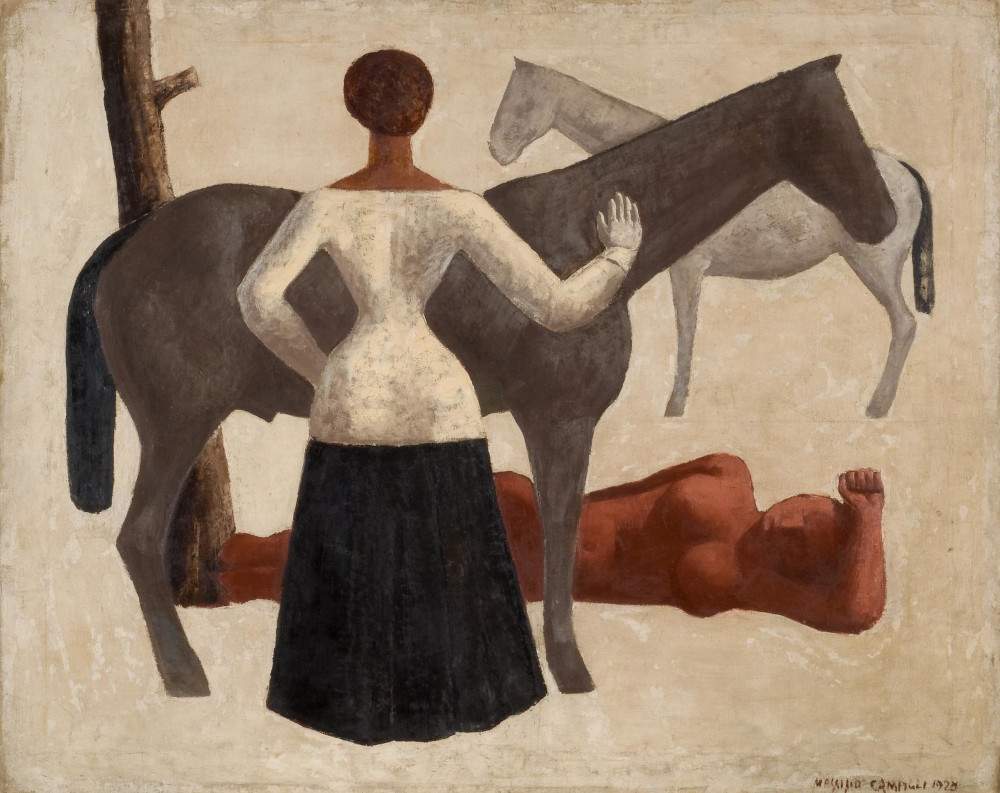From May 22, 2022 to January 29, 2023, the MASI Museo d’Arte della Svizzera Italiana in Lugano presents, thanks to the collaboration with the Fondazione Musei Civici di Venezia, a selection of thirty masterpieces ofItalian art created between the two wars by the most important artists of the time-Carlo Carrà, Massimo Campigli, Giacomo Manzù, Ottone Rosai, Scipione and Mario Sironi. Curated by Cristina Sonderegger, the exhibition A Collection of Modern Italian Art. Carrà, Campigli, Manzù, Rosai, Scipione, and Sironi presents works that come from historic Italian art collections and have recently entered as a long-term deposit to the International Gallery of Modern Art at Ca’ Pesaro in Venice.
With the exception of Scipione and Manzù, who follow more independent trajectories, the artists present with their works in the exhibition are linked by a common path: after the experience of the avant-garde, and, for some, the war, they adhere to the principles of return to order of the Italian Novecento group. The overcoming of the avant-gardes, particularly the Futurist one, was expressed in the recovery of classical forms and the compositional and formal simplification proper to the Italian primitive and Renaissance tradition. In this sense, the paintings on display are stylistically united by the search for synthesis, harmony and formal essentiality.
The exhibition layout follows an order by author and presents several masterpieces that mark fundamental stylistic and thematic choices in the work of individual artists, or tell a relevant collecting and exhibition history. Visitors are thus invited to discover significant examples such as Campigli’s famous painting The Amazons or Bejeweled Woman, works such as Carrà’s Casine sul Sesia and Morning by the Sea, Ottone Rosai’s Patch Players and Street Vendor, Manzù’s sculptures Girl on a Chair and Cardinal, and Scipione’s series dedicated to Cardinal Dean. Ideally opening the exhibition are Mario Sironi’s paintings Pandora and Il bevitore, the latter part of the Sarfatti collection until the 1950s. Made between 1923-24, Il bevitore is a significant example of the experimental phase in which Sironi sought to reconcile Novecentista solidity with formal solutions linked to the avant-garde. Pandora, on the other hand, marks an important stage in the artist’s maturity: here the female nude is reduced to a motionless monumental figure, of an ancient statue, against the backdrop of a rocky, primordial landscape reminiscent of those of Leonardo da Vinci.
The journey through Italian art between the wars continues with five paintings by Massimo Campigli, including the canvas The Amazons made by the artist in 1928 after his fascination withEtruscan art during a visit to the Roman museum of Villa Giulia.Attention to the female figure is a constant in Campigli’s art and is also found in the two frontal female portraits, such as Veiled Woman and Bejeweled Woman. The latter was painted in 1942 in Venice, where the painter moved when the war broke out and where it was exhibited at his solo show at the Cavallino gallery a couple of years later.
Balance, composure and recovery of a classical compositional form: these were the principles of that return to order of which Carrà became a full interpreter in the early 1920s. In his Mattino sul mare, painted in 1928 in Forte dei Marmi, the seascape is simplified to the power of an archetypal image. A similar reduction of the landscape to its minimal constituent elements also distinguishes the 1924 canvas Casine sul Sesia.
Ottone Rosai’s is a straightforward language that seeks synthesis and essentiality. In The Patch Players (1920), a subject to which the artist would return throughout his career, the group of street characters is rendered by subtraction. Vibrating instead with bright colors and daring perspectives are the works of Gino Bonichi, known as Scipione, an artist who died prematurely and who stood in dissent from the regime and the realism of the Novecento group. On display, his Sketch for the Portrait of Card inal Dean and Study for Cardinal Dean are part of a cycle on Cardinal Vincenzo Vannutelli, culminating in the portrait preserved at the Municipal Gallery of Modern and Contemporary Art in Rome.
Attention to the cardinal image also accompanies the work of Giacomo Manzù, who was impressed by it during a ceremony at St. Peter’s. In his 1952 sculpture Cardinal, blocked forms and a simplified treatment erect the ecclesiastic to an emblematic image. In contrast, the Girl in the Chair, a life-size sculpture from 1949, almost resembles a live cast.
For info: masilugano.ch
Image: Massimo Campigli, The Amazons (1928; oil on canvas; private collection on long-term deposit at Ca’ Pesaro - Galleria Internazionale d’Arte Moderna - Fondazione Musei Civici di Venezia) © 2022, ProLitteris, Zurich
 |
| At MASI Lugano masterpieces of Italian art between the wars from the collections of Ca' Pesaro, from Carrà to Sironi |
Warning: the translation into English of the original Italian article was created using automatic tools. We undertake to review all articles, but we do not guarantee the total absence of inaccuracies in the translation due to the program. You can find the original by clicking on the ITA button. If you find any mistake,please contact us.